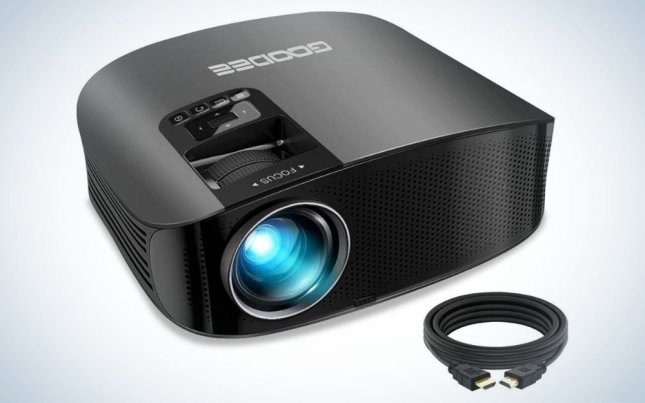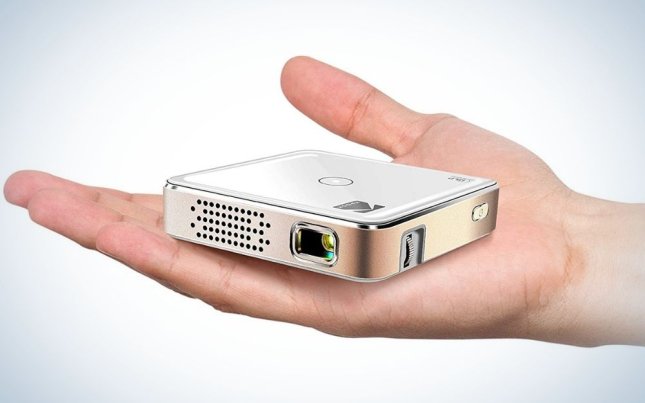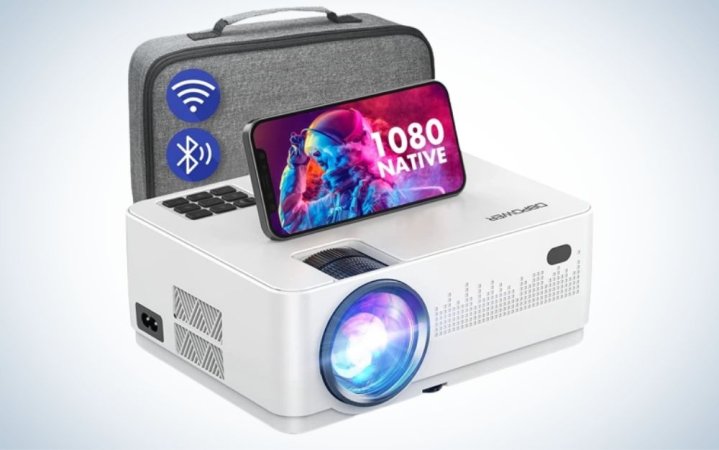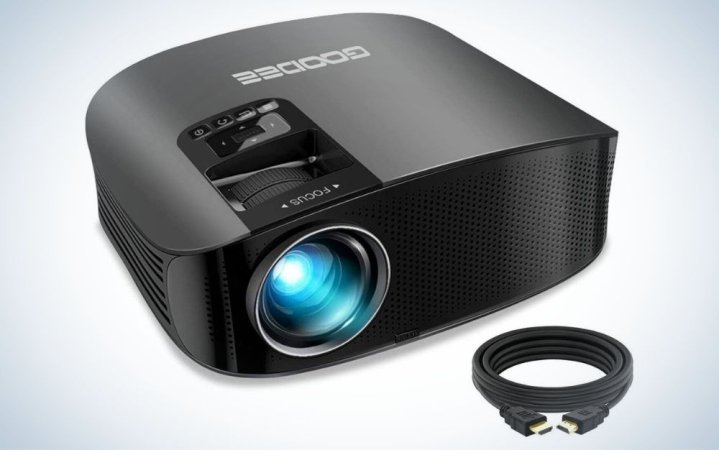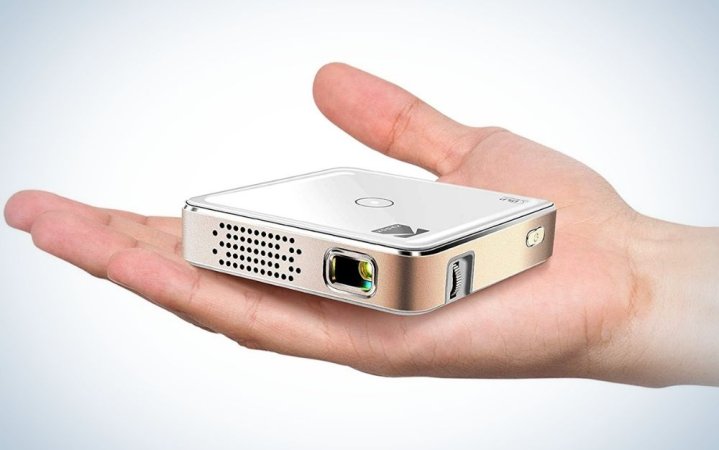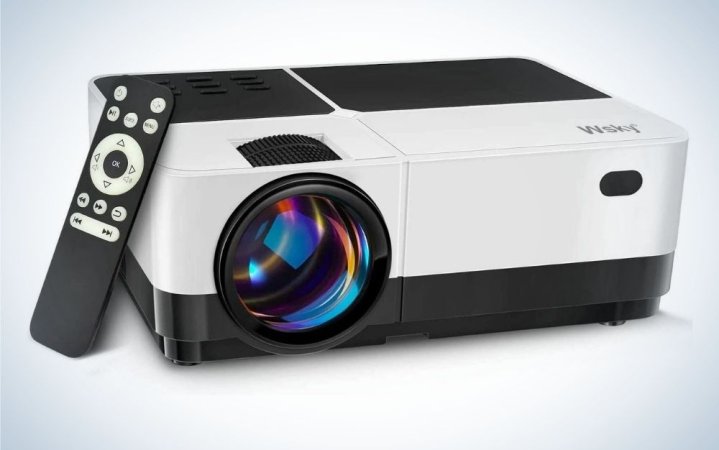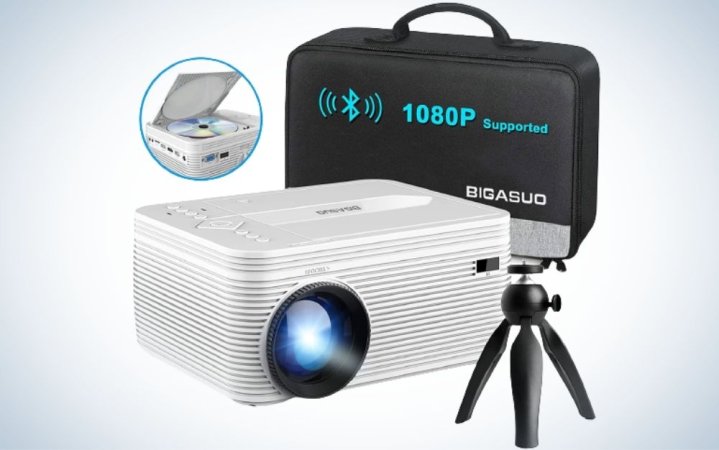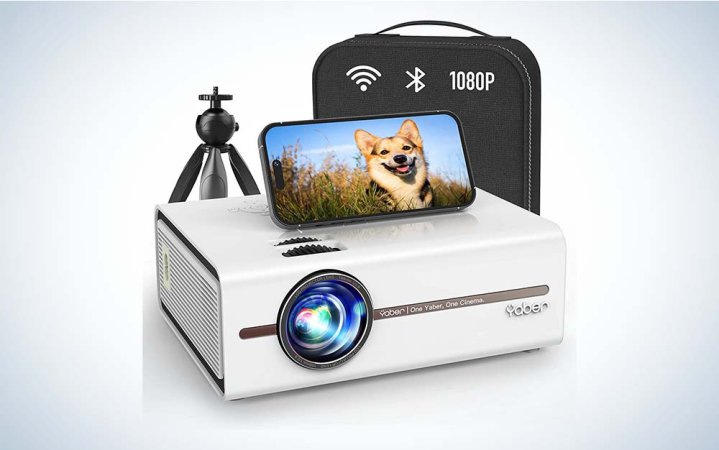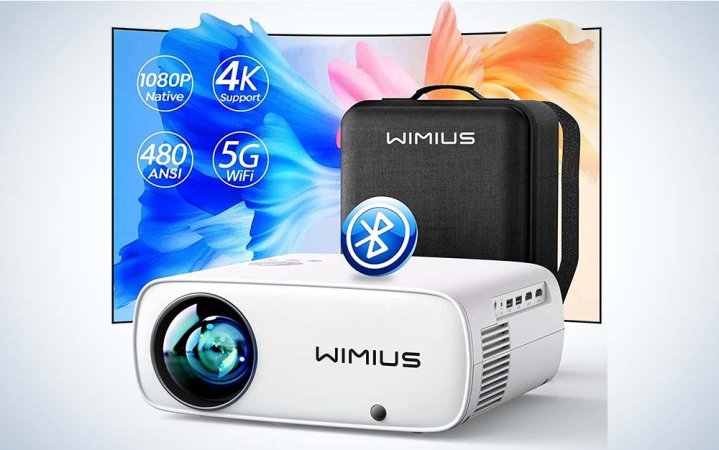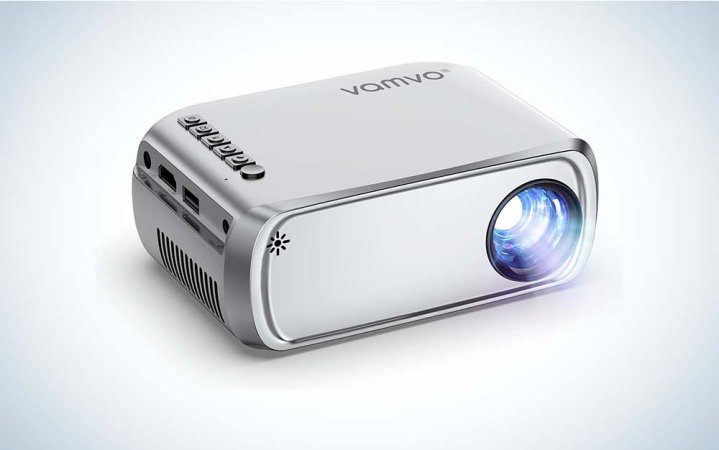We may earn revenue from the products available on this page and participate in affiliate programs. Learn more ›
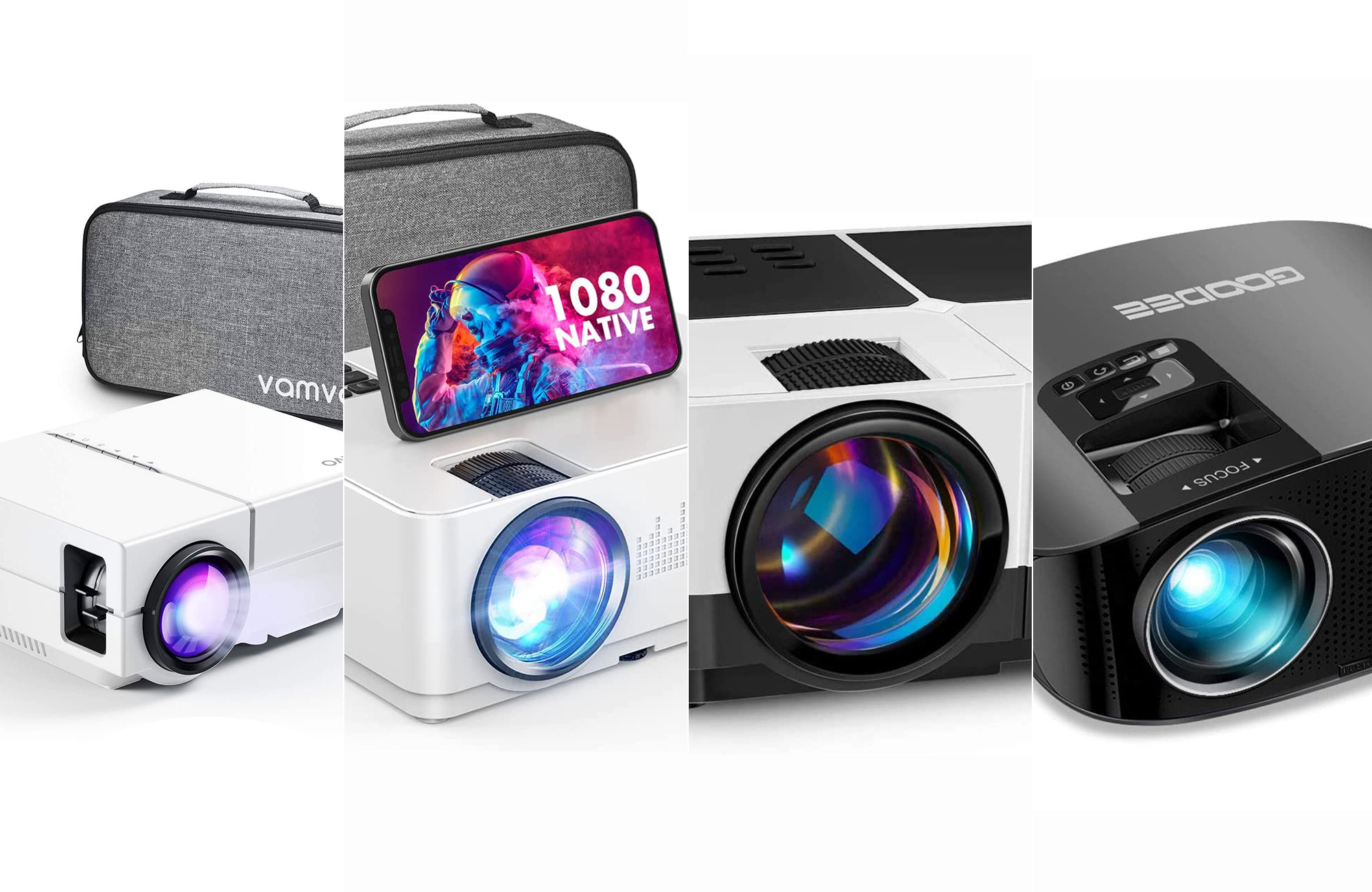
Projectors do wonders at making any room—even minuscule city apartments—feel like a home theater. And not all projectors require a big investment to open up a huge new window of immersive entertainment. If you’re ready to expand your laptop binges and smartphone scrolling to the size of your wall, you can explore the world of streaming content at a surprisingly affordable price. You shouldn’t expect top-tier performance at this price point, but the best projectors under $200 can still provide a satisfying experience if you choose the right model and do a little prep work.
- Best overall: DBPOWER WiFi Bluetooth Projector
- Best bright image: Projector, GooDee 2023
- Best portable: Kodak Ultra Mini Portable Projector
- Best for home theater: Wsky HD Projector (Refurbished)
- Best with DVD player: BIGASUO Upgrade HD Bluetooth Projector
- Best with screen: YABER WiFi 9000L
- Best for gaming: WiMiUS S26 Projector
- Best budget: Vamvo Mini Movie Projector
How we chose the best projectors under $200
Having spent countless nights watching YouTube with my girlfriend’s cat at the foot of the bed purring and curled up around the projector’s exhaust fan, I know the joys of a simple-to-use home projector. For this best-of list, I evaluated leading projectors from numerous manufacturers, looking for the magic combination of a few factors that add up to make some truly great picks. We narrowed down this list from dozens based on intensive research, editorial reviews, and spec comparisons.
The best projectors under $200: Reviews & Recommendations
These projectors offer surprisingly capable combinations of tech features that capitalize on crisp definition, Apollonian illumination, dynamic sound, and the connectivity you need for nightly use. Most hook into your laptop using an HDMI cable, while some pair wirelessly through a WiFi network. For audio, many pair with powered speakers (or an AV receiver) via aux connections and sometimes support Bluetooth. At the $200 price point, few projectors may be completely cord-free or the perfect pairing for your premium sound systems, but they could be a great partner to that new portable party speaker. Still, today’s budget projectors offer versatility and delivery that would have been unthinkable at this price a decade ago.
Best overall: DBPOWER WiFi Bluetooth Projector
The best overall
Clear Picture
Pros
- Really nice picture with good definition and bright luminance
- Solid connectivity options
- Allows viewers to screencast from their phones
Cons
- Bluetooth connection is only sound, advertising is misleading
- Some high-end sound systems won’t connect
Why it made the cut: With native HD, 9,000 lumens, and WiFi connectivity, this is a versatile and powerful projector, but it’s the customer support that makes it the best overall.
Specs
- Luminance: 9,000 lumens
- Definition: 1080p
- Connections: HDMI, WiFi, Bluetooth (sound), TV stick, USB, AV port, 3.5mm audio
This projector hits all the basics with aplomb: It offers 1080p definition without much warping along the edges, delivers 9,000 lumens to be visible in half-light conditions, and features impressive connectivity options. That connectivity lets you pair your devices to the projector via WiFi to screencast from a phone, or connect a sound system via Bluetooth. However, it will not deliver video via Bluetooth. That’s typical, but the product listings make it slightly confusing.
The projector also delivers a few special features, such as a zoom function that allows you to shrink the image to 75% via the remote. Built-in speakers create a modicum of surround sound illusion. However, we think you’ll be best served by connecting to a separate Bluetooth speaker device.
Best bright image: GooDee 2022 Projector
Best bright image
Killing Me Brightly
Pros
- Two speakers for true stereo sound
- Extra bright LED luminance
- Decent connections
Cons
- Build quality is a bit cheap
- Edges get somewhat fuzzy
Why it made the cut: With 1080p native resolution, 9,500 lumens, and two speakers to create a modicum of surround sound, this projector is more than capable of achieving most of what most users want.
Specs
- Luminance: 9,500 lumens
- Definition: 1080p
- Connections: 2 HDMI, VGA, 2 USB, AV, TF card
At the sub-$200 price point, it can be hard to find a projector with really excellent brightness. The GooDee 2022 distinguishes itself here. Offering 9,500 lumens with a 3,000:1 contrast ratio and a max screen size of 230 inches, this budget projector emphasizes going big. A pretty perfect option for backyard movie nights, this might be the best outdoor projector under $200, hitting a nice sweet spot of big image and lightweight build.
The GooDee does have a little trouble with warping and fuzziness around the image corners. However, that’s nothing rare at this price point. The device also suffers from a somewhat cheap-feeling build. It doesn’t feel super solid and primed for longevity. Still, the brightness and resolution may compensate for this for most users.
All in all, GooDee delivers a projector that yields a pretty bright, crisp image, with good contrast and resolution. It’s especially suited for backyard movie parties.
Best portable: Kodak Ultra Mini Portable Projector
Best portable projector under $200
Pocket Projector
Pros
- Ultra-portable
- Makes a great camping projector
Cons
- Battery often dies in under two hours
Why it made the cut: With support for 1080p signal and a two-hour battery charge, this super-petite projector fits in a pocket and makes for a perfect companion for campers with kids or travel.
Specs
- Luminance: 25 ANSI lumen
- Definition: 640 x 320 (capable of displaying images meant for 1080p)
- Connections: HDMI, USB, MicroSD
Ready to bring your projector camping? The Kodak Ultra Mini projector does some amazing things, considering its size. At about 3 inches square and only 150 grams, the Kodak lives up to its title as a true “ultra-mini” projector housed in that tiny body is a decent projector that hooks up to most smartphones and portable devices.
With such a tiny size and low price, the Ultra-Mini will require you to make some sacrifices. While it can receive a 1080p signal, it only outputs at 640 x 320, meaning the 1080p video entering the projector will be downscaled to a much lower native resolution. It’s quite a drop from HD, so don’t expect crisp, beautiful video that perfectly represents contemporary cinema. Additionally, the brightness isn’t anything to write home about. Still, it’s nothing to sneer at on a dark tent wall. One other issue with the device is its short battery life. It generally won’t make it past two hours, so don’t expect any Lord Of The Rings marathon binges here.
If a miniature portable projector is something you’re after and you decide you can afford the bells and whistles, Kodak’s more expensive Luma 350 could be worth exploring. For its small price and equally tiny size, however, the Kodak Ultra Mini is the best mini projector under $200. It’s worth a look, even if it could be a good idea to get your expectations in order before you spring for it.
Best for home theater: Wsky HD Projector (Refurbished)
Best projector for home theater under $200
Better Image
Pros
- 84 LEDs double the standard LED count in a projector and achieve greater detail, contrast, and less fuzziness on the exterior of the image
- Value priced
Cons
- Sound quality isn’t great
Why it made the cut: With a native 1080p HD resolution and a significantly higher-than-average 5,000:1 contrast, this projector puts its double-dense LED tech to work.
Specs
- Luminance: 7,500 lumens
- Definition: 1080p
- Connections: HDMI, VGA, audio port, USB, MHL
For a sub-$200 cinephiles projector, look no further than the Wsky HD Projector. This projector puts the work in on image quality using a higher-than-average LED count. The 5,000:1 contrast is noticeably better than much of the competition, and the 1080p HD coverage looks great, even with new movies. With better-than-average corner coverage achieved via the keystone wheel, Wsky also doesn’t suffer from as much of the edge blurriness that might make subtitles illegible on some projectors.
The Wsky’s sound won’t rack up any bonus points, however. While it advertises Dolby sound, the two speakers aren’t powerful enough. However, plugging speakers into the audio jack can mitigate this sound deficiency. Sadly, no Bluetooth audio connection is available. However, those who stump for Bluetooth speakers may be able to pair them to a device that’s sourcing video (such as your laptop, though there might be sync issues).
With its impressive video capabilities, the Wsky HD Projector is worth consideration for anyone who wants a projector that yields a great picture.
Best with DVD player: BIGASUO Upgrade HD Bluetooth Projector
Best with DVD player
Retrospective Outfitters
Pros
- DVD player built in
- Decent connectivity, including Bluetooth for sound
Cons
- Resolution and brightness are both somewhat low
- Sound is nothing to write home about
Why it made the cut: For folks with a legacy DVD collection who might want to skip all the wires, this projector has a built-in DVD player and does a decent job at all the rest.
Specs
- Luminance: 5,500 lumens
- Definition: 720p
- Connections: HDMI, VGA, AV, USB, Bluetooth (sound), TF SD card
Are you itching to tuck into the entire Lassie television series on DVD box set? The BIGASUO Upgrade HD projector with a built-in DVD player might be your best bet. The BIGASUO projector is remarkable for its connections and legacy media opportunities.
The Bluetooth connection for sound is particularly useful in concert with the built-in DVD player. Often with contemporary laptops, Bluetooth sound on a projector is redundant since most laptops can pair to a Bluetooth speaker while casting video through HDMI. However, since this device acts as its own DVD player, the Bluetooth connection can be important for those skipping the laptop entirely. This means you can natively watch DVDs from the device while simultaneously paired with a Bluetooth speaker for sound.
Outside of its DVD player, this is an unremarkable projector. It downscales HD video to its native 720p definition, which falls short of similarly priced native HD projectors. Its brightness similarly lags the competition somewhat.
If you’re looking for a capable all-in-one DVD player/projector hybrid, the BIGASUO Upgrade HD is a good pick. Otherwise, you may want to move on.
Best with screen: YABER WiFi 9000L
Best with screen
Screen Included
Pros
- Includes projection screen, which is primed for contrast
- Decently bright
- Lightweight and portable at just over two pounds
Cons
- Resolution could be better
Why it made the cut: The Yaber boasts an impressive 10,000:1 contrast, supplemented by an included SCT screen that improves the image.
Specs
- Luminance: 9,500 lumens
- Definition: 1080p
- Connections: HDMI, USB, VGA, AV, audio, TF card
Pay for a projector, get the whole shebang? You’ll get just that with the YABER WiFi 9000L, which features a projection screen included in the box. While lots of folks use their projectors on a blank wall, you can demonstrably get a better image with a specially designed projection screen.
The rest of the YABER’s specs are average. It features a 1080p native resolution, and its brightness is better than average but not outstanding. It uses two speakers for decent sound. The WiFi connectivity is a nice touch that may sway some buyers. That, coupled with the 10,000:1 high definition, makes for a good all-around projector that’s a perfect addition to some households.
Best for gaming: WiMiUS S26 Projector
Best projector for gaming under $200
Best For Prime Owners
Pros
- Great video quality with very bright and detailed image
- Relatively low lag makes it worthy of games
- With a wider-than-average keystone correction capability, you’ll get a more balanced picture
Cons
- “4K” claim refers to 4K video input, which is standard and downgraded to HD
- Edges of the picture remain fuzzy
Why it made the cut: This HD projector isn’t actually true 4K, but it does deliver 1080p video at gaming speeds, extra bright 480 ANSI lumens, 20,000:1 contrast ratio, and extra nice keystone correction.
Specs
- Luminance: 480 ANSI lumens
- Definition: 1080p
- Connections: HDMI, USB, AV, 1 audio output
Available for a solid sale price more often than not, the WiMiUS S26 fits within the $200 mark for our purposes. While the false 4K advertising is certainly a turn-off, the projector is still a good enough deal to highlight on this list.
This projector has a classic HD 1920×1080 resolution, make no mistake. The 4K claim simply refers to the projector’s ability to accept 4K video and downscale it to HD, which is common. Still, this projector throws a nice-looking image: It has the highest contrast ratio of any projector on this list, with about 1,152 LED lumens (480 ANSI lumens) that should appeal to gamers. That said, the image has some issues; its edges tend to blur, with the middle properly focusing and the corners getting fuzzy.
In the end, this is a pretty capable extra bright projector. But don’t be fooled by the advertising … this isn’t a magical unicorn 4K projector for under $200.
Best budget: Vamvo Mini Movie Projector
Best budget
Value Among Deals
Pros
- Better sound delivery than most at this price
- Lightweight build makes it a great choice for a portable option
- Decently bright
Cons
- Non-HD picture is a bit blurry
Why it made the cut: With its two built-in speakers, 720p resolution, and under 1-pound weight, Vamvo dishes up a budget projector that does a really decent job.
Specs
- Luminance: 3,500 lumens
- Definition: 720p
- Connections: HDMI, VGA, SD/TF, AV, USB and RC
For a truly low price for its capabilities, the Vamvo Mini Movie Projector is the value pick for budget projectors. This 720p projector still delivers a decent enough high-contrast picture that’s adequately bright in dark rooms at 3,500 lumens, so that it’s effective in moderately dark to very dark spaces. While it advertises its support for 1080p HD, the 720p resolution will mean that high-end pictures do downgrade and lose detail. If you’re just watching the occasional movie in a dark backyard on a DIY screen or sheet, that may not matter very much.
The projector’s speakers certainly fall short of outstanding. Still, you can’t knock the performance here for the price point. It does a better job than most at this level. Overall, Vamvo is a true budget projector. While none of its components outpace the best equipped of the competition, if a low price is your most important metric, then it’s worth real consideration for its decent treatment of all the basics. At about just under a pound, this Vamvo is portable, reliable, and very cheap.
Things to consider when shopping for the best projectors under $200
You won’t get a chance to try out these projectors before you take the leap and buy one, but you can get a good idea of what you’re getting by comparing the specs. Here are some essential features to look for when trying to pick the best model for you.
Do you need 4K?
4K is all the rage (until 8K finally establishes itself), and while I type this article on a laptop with a 4K screen, the resolution difference between 1080p and 4K at that scale is subtle. However, a top-tier projector is arguably one of the best applications of 4K resolution. Since projectors often cast their image onto large surfaces, the more pixels the projector displays, the better it looks at visual detail. That said, true 4K resolution is currently prohibitively expensive for an “under $200” list.
The difference between 1080p and a resolution like 720p is quite drastic. With a difference of 1080 lines of pixel dots versus 720 lines of pixel dots, you will notice the difference, especially if you’re projecting large. Generally, a substantive price difference separates the standard resolution brackets. So unless you are dedicated to getting the most portable projector out there, the choice should generally come down to budget vs. resolution. Go for the 1080p model unless image quality really isn’t important to you.
Read the fine print
Yeah, you want to believe that companies are being transparent about their products, but there’s a lot of bluster in the budget projector market. Often companies will claim their product supports HD in a header, then reveal that it has a native resolution of 720p, accepting HD video and downscaling it. It’s important to fully examine the specs of the projector you’re considering purchasing to ensure that it’s really the right one for you.
Keystone effect
Keystone correction refers to the illusion that’s created when your projector casts a square image onto a wall at an angle, creating a trapezoid. The shape created looks like the crowning keystone a mason would use to construct an arch.
Today’s projectors compensate for the keystone effect by including a control that skews the image. This control usually takes the shape of a ring or nob by the focus control. Keystone correction can also be added digitally.
Some projectors are better at keystone correction than others. But all projectors can benefit from supplementing keystone compensation with proper alignment of the projector against the wall. For permanent installation, getting the projector alignment right the first time is usually a good idea. Whether your projector will be installed permanently, or be moved around the house (or beyond), it’s worth understanding Keystone controls before you make a final decision.
Screen or wall?
Screens can make a huge difference in the image quality you get from your projector. Painted walls often contain more bumps and crevasses than you would expect. Not only do projector screens deliver a flat uniform surface, but they also often come primed with materials that help your projector do its work. Some projectors ship with a screen in the package. Many others would benefit from one. It’s worth considering whether you want to invest in a projector screen.
Luminance
Most of the time, projectors with the highest luminance are better than others for most users. Since projectors work by casting light onto a wall, higher luminance equals a brighter, more visible image, that will show up in half-light settings and on surfaces that aren’t primed for contrast. Usually, companies describe luminance in terms of lumens, which is the International System of Units standard for measuring total light emission over a unit of time. Sometimes, projectors advertise their brightness using the term “ANSI lumens,” a (generally) more accurate metric created by the American National Standards Institute for measuring total light emitted from a projector. While ANSI lumens aren’t directly convertible to lumens without accounting for a few additional factors (such as room temperature and surface color), 400 ANSI lumens roughly translates to a little under 1000 lumens. For this article, we prioritized higher luminance in most cases.
Picture quality and definition
We’re in the era of 4K, and while a 4K resolution projector is rarely achievable for less than $200 (though we’ve got some great choices starting at $500), HD has become the bottom line in most cases. Many projectors still offer less than 1080p resolutions, and some are still worth considering, especially if you’re stumping for ultra-portability (or ultra-cheap prices). Still, most of the time, 1080p HD is the baseline we look for in a model designed for watching content. It creates a detailed image that does justice to your Criterion Collection binges. Definition isn’t the whole story, though: some projectors warp or blur image edges, skewing the picture. Other factors like contrast and color reproduction can also affect quality. This list prioritizes projectors that achieve image quality that displays the worlds you escape in how the director (or game designer) envisioned them.
Connectivity
At the sub-$200 price point, most projectors use HDMI cables for video connection. A few offer WiFi connections to supplement this. A few even offer Bluetooth connectivity. I factored in a projector’s connection offerings when I evaluated it and highlighted any that stand out from the crowd.
FAQs
At the sub-$200 price point, DBPOWER is the most all-around capable projector. You also get solid support along with your purchase.
Great projectors under $200 offer solid brightness, which usually delivers 5,000 lumens and up, HD video, good connectivity, and reliable customer service.
No projector can keep up with the luminance of the sun. Projectors that deliver the maximum possible lumens do the best outdoors; in the under $200 category, look for projectors that deliver 7,000 lumens and up, and 9,000-9,500 would be best.
Certain mini portable projectors that emphasize small size can justify low brightness and still qualify as good quality. However, generally, 5,000 lumens and up makes a good projector brightness.
The Vamvo Mini Movie Projector dishes up lean, mean video for under $100. With HD video, 3,5005-lumen brightness, and good connectivity, it’s a steal.
The WiMiUS S26 Projector is a powerful gamer-ready projector. Its impressive video does justice to the PlayStation 5’s graphics. At just under $200, it’s a great choice. If you’re moving up to the PS5, though, you might want to consider larger, albeit more expensive projectors, or you’re just wasting all that next-gen game engine.
While so many components factor into the lifespan of your tech. Companies often advertise the lifespan of the LEDs or other light sources that power their projectors. Some are primed to last for 10 years, while others may only deliver about a year.
Final thoughts on the best projectors under $200
- Best overall: DBPOWER WiFi Bluetooth Projector
- Best bright image: Projector, GooDee 2022
- Best portable: Kodak Ultra Mini Portable Projector
- Best for home theater: Wsky HD Projector (Refurbished)
- Best with DVD player: BIGASUO Upgrade HD Bluetooth Projector
- Best with screen: YABER WiFi 9000L
- Best for gaming: WiMiUS S26 Projector
- Best budget: Vamvo Mini Movie Projector
The best projectors under $200 offer tuned combinations of value and performance. You’ll find HD video, bright high-lumen LEDs, and solid connectivity at the price point. You can also find ultra-mini projectors capable of projecting from a phone or tablet and easily fit into a shirt pocket. For one of the best value projectors around, the Vamvo Mini Movie Projector delivers good video and brightness at a super-budget price. The Wsky HD Projector, with its impressive LED tech, is our favorite for home theater, though you might want to pair it with external speakers. DBPOWER, on the other hand, was the clear choice for the overall best projector under $200 for its HD video, good brightness, connectivity, and a customer service plan and warranty that goes far beyond most on this list. Whatever you pick, enjoy the new dimensions of video and picture quality that your projector will bring to your home media.

